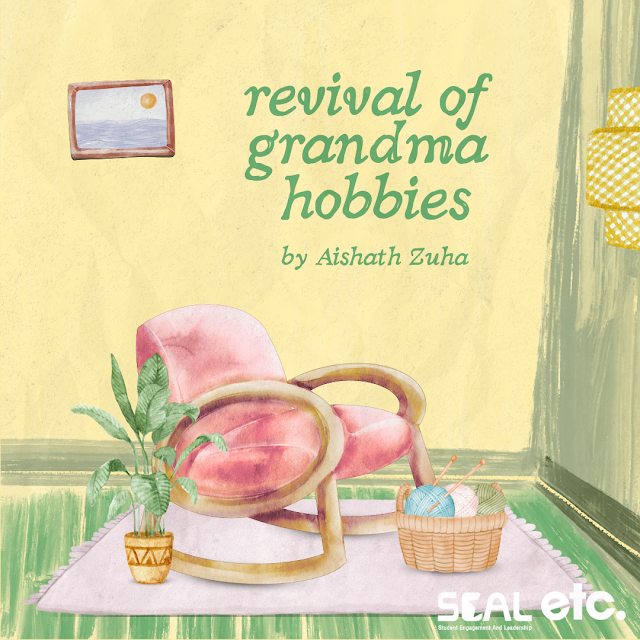Revival of Grandma Hobbies | By Aishath Zuha
 |
| by @ooutofhere |
Once upon a time, traditional pastimes like knitting, baking, gardening and embroidery were considered as hobbies meant for retirement homes and nostalgic movies. However, as the digital world speeds up, it seems the new generation is slowing down, with one handmade stitch at a time. Across campuses and social media feeds, young people are picking up crochet hooks, watering heirloom tomatoes, and proudly showcasing their latest sourdough loaves. This isn’t about birdwatching or sewing tote bags for clout. It is a cultural shift across an entire generation. Far from being outdated, these “grandma hobbies” are now symbols of mindfulness, sustainability, and personal expression. So, why are these hobbies back in style? And what does that say about us?
Despite the nickname, “grandma hobbies” aren’t limited to age. They are a growing collection of traditional, hands-on activities that have found a new life among younger generations. Think knitting, embroidery, crocheting, gardening, baking, quilting, and even letter-writing. While once associated with our older relatives or rural life, these hobbies are now wrapped up in aesthetic appeal and proudly shown off on TikTok, Pinterest, and Instagram. The rise of trends like “grandma-core” or “cottagecore” with their cozy visuals, floral patterns and appreciation for slow living has only accelerated the return of these crafts. What was once seen as boring or old-fashioned is now being rebranded as charming, intentional, and refreshingly online.
So, what’s behind the growing love for hobbies once tucked away in sewing baskets and backyard sheds? For many young people today, the intrigue lies in the contrast to modern life. In a world shaped by fast-paced content, endless notifications, and digital burnout, the slow hands-on activities offer a calming counterbalance. Knitting a scarf or nurturing a windowsill herb garden isn't just about productivity. It is also a form for mindfulness and a creative outlet.
There is also a deeper cultural shift at play. As conversations around sustainability and conscious living become more mainstream, people are turning to hobbies that feel more intentional. Activities once associated with nenek or kampung life like sewing baju, baking kuih from scratch, or growing pandan and serai in the backyard are making a comeback, not just as hobbies but as meaningful parts of daily life.
These aren’t just quaint throwbacks; they’re hands-on, heart-first ways of slowing down and reconnecting with culture. For many, these traditional hobbies have grown into long-term habits and passions that go beyond just online trends. Things like learning to knit, bake, or making sambal the traditional way isn’t just a novelty anymore; it’s become a part of daily routines, and in some cases, a core part of how people express themselves. There’s something deeply satisfying about creating something with your own hands especially in an age where everything is digital, disposable, and instant. Whether it’s the meditative rhythm of stitching or the quiet joy of watching a plant grow, these hobbies offer a sense of purpose and pride that’s hard to find elsewhere. They’ve moved away from being a temporary online fascination to a way people choose to live in a slower, more mindful and more intentional way. It's also about building identity through heritage and handmade effort. Whether it’s young people learning to make their grandma’s pineapple tart recipe for Raya or proudly wearing their own hand-embroidered tote to class, these hobbies have become quiet but powerful acts of cultural continuity and self-expression.
At first glance, the rise of traditional hobbies might look like another passing internet trend. But the growing interest suggests that something more meaningful is happening. While the aesthetic may have sparked attention, it’s the sense of fulfillment and calm that keeps people coming back. Once someone crochets their first coaster or harvests homegrown cili padi, they often find it hard to stop. Across Malaysia, workshops and markets are offering hands-on experiences in things like batik painting, sourdough baking, and even tempeh-making. These events often attract young people who are curious to learn something real and useful. Online spaces are just as lively, filled with people sharing their handmade crafts, home gardens, and baking wins.
Maybe it did begin as a trend, but now it’s growing into something more lasting — a quiet shift toward creativity, culture, and slowing down on purpose.






0 comments